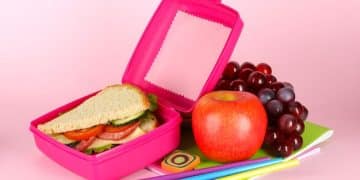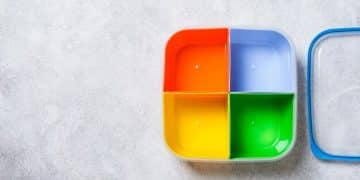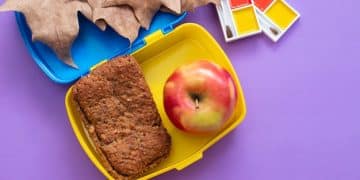Lunchbox Packing Hacks: Keep Food Fresh All Day
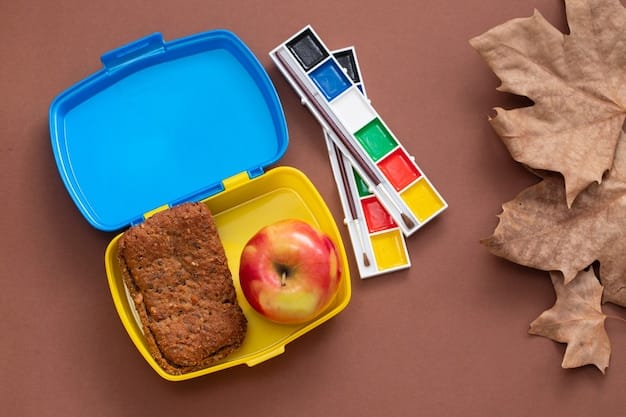
Lunchbox packing hacks are essential for ensuring that your food stays fresh, safe, and appealing throughout the day, involving smart choices like using insulated containers, including ice packs, and selecting foods that hold up well.
Getting ready for a day out, whether it’s school, work, or a picnic, often includes packing a lunchbox. But how do you ensure that the food you pack remains as fresh and appealing as when it left your kitchen? The secret lies in mastering some effective lunchbox packing hacks that not only keep your meals safe to eat but also make them enjoyable by lunchtime.
Mastering Temperature Control for Lunchbox Success
One of the most crucial aspects of keeping a lunchbox fresh is controlling the temperature. Bacteria thrive in temperatures between 40°F and 140°F, so keeping food either very cold or very hot is key to preventing spoilage and ensuring food safety.
The Importance of Insulated Containers
Insulated containers are a game-changer when it comes to maintaining the temperature of your food. These containers are designed to keep cold foods cold and hot foods hot for several hours.
- How they work: Insulated containers have double walls with a vacuum layer in between, which minimizes heat transfer.
- Best uses: Perfect for items like yogurt, soups, stews, or anything that you want to keep at a specific temperature.
- Preparation: For cold foods, pre-chill the container in the freezer for about 30 minutes before packing. For hot foods, fill the container with boiling water, let it sit for a few minutes, then empty it and add your hot food.
Choosing the right insulated container can make a significant difference. Look for containers that are durable, easy to clean, and have a tight seal to prevent leaks and maintain temperature.
Strategic Use of Ice Packs
Even with insulated containers, ice packs are your best friend for keeping your lunchbox contents cool. Proper placement and the right type of ice pack can maintain a safe temperature for hours.
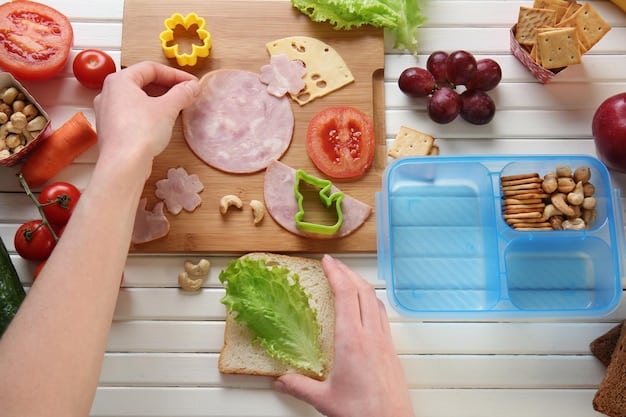
- Types of ice packs: Gel packs, hard plastic ice packs, and even frozen water bottles can work. Gel packs tend to stay colder for longer.
- Placement is key: Place ice packs on top of and next to items that need to stay cold, such as dairy products, meats, and salads.
- Multiple ice packs: For extra assurance, especially on hot days, use multiple ice packs to surround the food.
Consider the size and shape of your lunchbox when choosing ice packs. Slim ice packs fit well in tight spaces and can be placed strategically without taking up too much room.
Selecting Foods That Travel Well
The type of food you pack in your lunchbox also plays a crucial role in how fresh it remains. Some foods are simply better suited for being packed than others.
Fruits and Vegetables with Staying Power
Certain fruits and vegetables hold up better than others when packed in a lunchbox. Here are some top choices:
- Apples: Sliced or whole, apples are sturdy and don’t brown quickly if treated with a little lemon juice.
- Grapes: Easy to eat and stay fresh when packed properly.
- Carrots and celery: Crunchy and hydrating, these veggies don’t wilt easily.
- Berries: Strawberries, blueberries, and raspberries are great, but pack them in a hard container to prevent crushing.
Avoid fruits like bananas, which can become mushy, or leafy greens that wilt easily unless kept very cold and dry.
Sandwich Strategies
Sandwiches are a lunchbox staple, but they can sometimes become soggy or unappetizing. Here are some strategies to keep your sandwiches fresh:
- Spread smart: Instead of spreading condiments directly on the bread, consider packing them separately or using a barrier like lettuce or cheese between the bread and moist ingredients.
- Bread choice: Use hearty breads like whole wheat or sourdough, which are less likely to get soggy than soft white bread.
- Keep it dry: Wrap sandwiches tightly in plastic wrap or place them in a sandwich container to prevent moisture from getting in.
Consider alternatives to traditional sandwiches, such as wraps, pita pockets, or salads with the dressing packed separately.
Packing Techniques to Prevent Soggy Lunches
Even with the right foods and temperature control, poor packing can lead to soggy or unappetizing lunches. Proper packing techniques can make a big difference.
Layering Food Items
The order in which you layer food in your lunchbox can help maintain its freshness and prevent items from becoming soggy.
- Bottom layer: Place heavier, more durable items like fruits and vegetables at the bottom.
- Middle layer: Sandwiches or wraps go in the middle, wrapped tightly to protect them from moisture.
- Top layer: Lighter items like chips or crackers should go on top to prevent them from being crushed.
By layering your lunchbox strategically, you can ensure that each item stays in its best possible condition until lunchtime.
Using Dividers and Containers
Dividers and containers are essential tools for keeping your lunchbox organized and preventing different foods from mixing together. This is especially important for items that might make other foods soggy.
- Bento boxes: These Japanese-style lunchboxes have multiple compartments, perfect for keeping different foods separate.
- Small containers: Use small, reusable containers for items like dips, sauces, or dressings.
- Silicone cups: These flexible cups can be used to separate snacks like berries or nuts.
With the right dividers and containers, you can keep your lunchbox neat, organized, and prevent soggy surprises.
Creative Ways to Keep Lunches Exciting
Beyond freshness and safety, making lunchboxes exciting can encourage better eating habits and prevent food waste. A little creativity goes a long way.
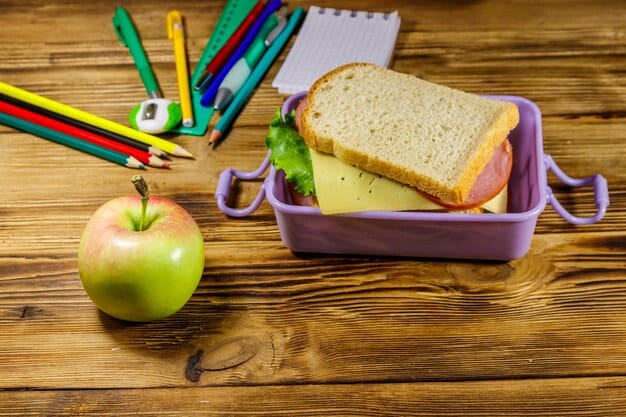
Presentation Matters
Making your lunchbox visually appealing can make it more enticing to eat. Simple touches like cutting sandwiches into fun shapes or arranging colorful fruits and vegetables can make a big difference.
- Cookie cutters: Use cookie cutters to create fun shapes with sandwiches, cheese, or fruits.
- Skewers: Thread fruits, vegetables, or cheese onto skewers for a fun and easy-to-eat snack.
- Color coordination: Arrange foods by color to make the lunchbox visually appealing.
Get the kids involved in packing their own lunchboxes. They’re more likely to eat what they packed themselves, and it’s a great way to teach them about healthy eating habits.
Adding Variety
Packing the same foods every day can lead to boredom and food waste. Adding variety to your lunchbox can keep things interesting and ensure you’re getting a balanced diet.
- Theme days: Create themed lunchboxes, such as “Mexican Monday” with quesadillas and salsa, or “Italian Tuesday” with pasta salad and mozzarella sticks.
- Leftovers: Repurpose leftovers from dinner into exciting lunchbox meals.
- Try new recipes: Experiment with new recipes and lunchbox ideas to keep things fresh.
Lunchbox packing doesn’t have to be a chore. With a little creativity and planning, you can create fun, exciting, and nutritious meals that everyone will enjoy.
Addressing Common Lunchbox Challenges
Despite your best efforts, common challenges can arise when packing lunchboxes. Addressing these issues proactively can save you time and frustration.
Preventing Leaks and Spills
Leaks and spills can be a major headache, especially when they involve sticky or messy foods. Here’s how to prevent them:
- Leak-proof containers: Invest in high-quality, leak-proof containers with tight seals.
- Pack liquids carefully: If you’re packing soups or dressings, make sure the container is upright and secure.
- Double-check seals: Always double-check that containers are properly sealed before placing them in the lunchbox.
Consider using reusable silicone lids instead of plastic wrap to create a tight seal on containers.
Dealing with Picky Eaters
Picky eaters can make lunchbox packing a challenge. Here are some strategies to encourage them to try new foods:
- Involve them in the process: Let picky eaters help choose and pack their lunchboxes.
- Introduce new foods gradually: Add small portions of new foods alongside familiar favorites.
- Be patient and persistent: It can take multiple tries for a picky eater to accept a new food.
Don’t give up on offering healthy options. Over time, picky eaters may become more open to trying new things.
| Key Point | Brief Description |
|---|---|
| 🧊 Temperature Control | Use insulated containers and ice packs to keep food at safe temperatures. |
| 🍎 Food Selection | Choose fruits, vegetables, and sandwich components that resist becoming soggy. |
| 🍱 Packing Techniques | Layer food items strategically and use dividers to keep items separate. |
| 🎨 Presentation & Variety | Make lunches appealing and varied to encourage consumption and reduce waste. |
Frequently Asked Questions
▼
With proper insulation and adequate ice packs, food can stay fresh for up to four hours. Ensure the ice packs are still partially frozen upon lunchtime for safe consumption.
▼
Yes, frozen juice boxes can serve as effective ice packs. They keep the lunchbox cool and provide a refreshing drink once thawed, which serves a dual purpose.
▼
Pack dressings separately and use a container with a tight seal. Layer the ingredients with lettuce at the top and heavier, wetter ingredients at the bottom.
▼
It is best to clean the lunchbox every day to prevent bacterial growth. Wipe it out with soap and water, and allow it to air dry completely before the next use.
▼
Reusable containers are more eco-friendly, cost-effective in the long run, and often provide better insulation, keeping the food fresher and safer for longer durations.
Conclusion
Mastering these lunchbox packing hacks will ensure that your meals remain fresh, safe, and appealing throughout the day. By focusing on temperature control, food selection, packing techniques, and a touch of creativity, you can conquer common lunchbox challenges and enjoy delicious, healthy meals wherever you go.
